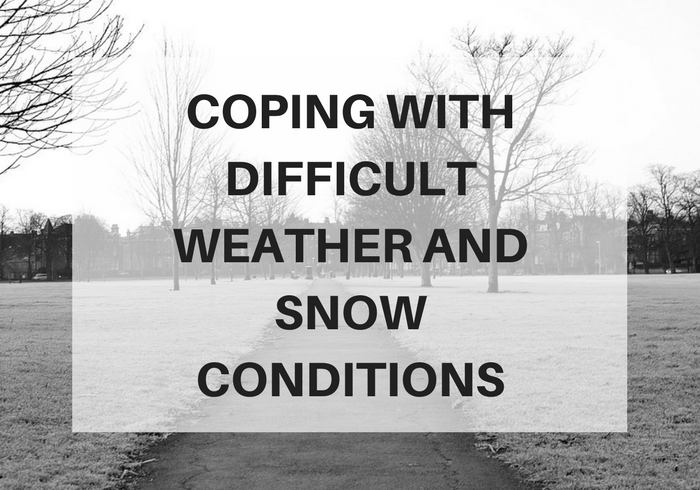Insights
Many slipping accidents occur at building entrances as people entering the building walk in rainwater. Fitting canopies of a good size over building entrances and in the right position can help to prevent these kinds of accidents. If a canopy is not a possibility, consider installing large, absorbent mats or even changing the entrance flooring to one which is non-slip.
You will find that slips and falls are the most common types of injuries at work during the winter months. You must remind your employees to avoid boots or shoes with smooth soles that are not sturdy on icy walkways. Wearing a pair of well insulated boots with rubber treads is advised, and walking slowly and carefully will decrease chances of falling.
Main pathways and steps that access the building should be cleared of any ice or snow to stop this from happening also, and it is important for your employees to shake off any snow on their boots, as this can result in floors becoming very wet and slippery when it melts.
As temperatures drop and traveling to work becomes riskier, it is crucial for employers to allow flexibility during harsh winter weather conditions.
Many of your employees may be unable to travel to work because of the snow and ice, but businesses do not have to suffer as a result. Businesses that implement sound business continuity and safety policies, in conjunction with an effective communication system should be more than able to continue with business as usual, in adverse weather conditions without putting their workforce in danger.
Employers have many factors to take into consideration at this time of year, including:
- Safety in the workplace
- Low temperatures
- Office closures and business continuity
- Employee, contractor and public safety
- Planning and implementation of communications
Swift decisions may need to be made in the event of unexpected weather conditions regarding closing the office and sending staff home. These judgments should always be made by considering the hazards and potential risks to your employees, as safety should always be at the forefront of this decision.
In the circumstances of extreme and dangerous weather, communication must be constant throughout your business. It is vital that your employees know what the company policy is, and who to talk to if they have any questions.
Below are a few health and safety issues that you may need to address as an employer:
- Risk assessment - You must decide who the decision makers are in the event of bad weather so that you know who has the responsibility for advising staff to leave the workplace, or if your office is closing for a certain period of time. The five stages of risk assessment should be applied, as always, and a decision made by a competent individual.
Following the risk assessment, a safe system for dealing with wintery conditions should be developed and implemented along the following lines:
- Named individuals should be responsible for clearing a suitable path through the snow/ice and treating it.
- The clearing of snow, ice and dealing with it should be done at the most appropriate time - before most staff arrive.
- A named individual should be responsible for monitoring the stocks of sand or grit and restocking as required.
- A named individual should also be responsible for ensuring that the system works.
- Include a check on weather forecastt
- It should also deal with the option to close the office and take into consideration, who makes that decision?
- Based on what criteria?
- How is it communicated?
- For many sites, a plan may be required to identify priority areas for clearing and dealing with snow and ice. A sensible order would be areas where cars and pedestrian mix, then paths, then fire escape exits etc.
- When the snow has been cleared it is important to combine it with gritting to avoid making the surface even more slippery.
- Signage should be considered to warn of slippery surfaces, particularly for extensive areas where clearing or gritting cannot be undertaken. But remember the option to close this area.
- Individuals should be reminded to take extra care, even when clearance and/or gritting have been undertaken, as conditions can remain slippery
At this time of year there may be fewer people in the workplace, and so it is very important to maintain communication with your employees and ensure that all unnecessary jobs are put on hold. You should also have consideration for employees that are more vulnerable such as disabled or pregnant staff.
With lower staffing levels which may occur during this period, making arrangements to deal with emergencies should be considered. The types of emergencies that could occur are: failure of safety critical systems; first aid incidents; power failures; fire evacuations.
You must ensure that all staff who travel to work by car are allowed extra time to complete their journeys and are not pressurised to make the journey to work if their route is affected by extreme weather.
Working from home is a good solution if employees cannot get into work due to the weather. However, employers should be aware that it is their responsibility to ensure that their employees’ health is at the forefront of priority. Therefore, home working assessments should also be undertaken to ensure that it is safe and comfortable to work from home; and that they have the means to do so.
If your employees are required to work outside, then you must ensure that suitable and sufficient PPE is provided.
How Alcumus can help
Good risk management and sound health and safety advice should lead to a reduced risk to employees’ during difficult weather and snow conditions. With qualified consultants and technical expertise behind us, your Alcumus Health and safety Consultant applies knowledge of the law, Approved Codes of Practice and other guidance which can help fulfil the duty of care you have to your employees. We are also able to advise on any additional requirements.
Gary Broadley CMIOSH TIFireE OSCHR
Senior Health & Safety Consultant






